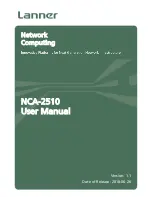
22-4
Cisco Catalyst Blade Switch 3130 and 3032 for Dell Software Configuration Guide
OL-12247-04
Chapter 22 Configuring DHCP Features and IP Source Guard
Understanding DHCP Features
is an example of a blade switch in an enclosure in which a centralized DHCP server assigns
IP addresses to subscribers connected to the switch at the access layer. Because the DHCP clients and
their associated DHCP server do not reside on the same IP network or subnet, a DHCP relay agent (the
blade switch) is configured with a helper address to enable broadcast forwarding and to transfer DHCP
messages between the clients and the server.
Figure 22-1
DHCP Relay Agent in a Metropolitan Ethernet Network
When you enable the DHCP snooping information option 82 on the switch, this sequence of
events occurs:
•
The Blade Server (DHCP client) generates a DHCP request and broadcasts it on the network.
•
When the blade switch receives the DHCP request, it adds the option-82 information in the packet.
By default, the remote-ID suboption is the switch MAC address, and the circuit-ID suboption is the
port identifier,
vlan-mod-port
, from which the packet is received.You can configure the remote ID
and circuit ID. For information on configuring these suboptions, see the
and Option 82” section on page 22-12
.
•
If the IP address of the relay agent is configured, the switch adds this IP address in the DHCP packet.
•
The blade switch forwards the DHCP request that includes the option-82 field to the DHCP server.
•
The DHCP server receives the packet. If the server is option-82-capable, it can use the remote ID,
the circuit ID, or both to assign IP addresses and implement policies, such as restricting the number
of IP addresses that can be assigned to a single remote ID or circuit ID. Then the DHCP server
echoes the option-82 field in the DHCP reply.
•
The DHCP server unicasts the reply to the blade switch if the request was relayed to the server by
the switch. The switch verifies that it originally inserted the option-82 data by inspecting the
remote ID and possibly the circuit ID fields. The switch removes the option-82 field and forwards
the packet to the switch port that connects to the DHCP client that sent the DHCP request.
In the default suboption configuration, when the described sequence of events occurs, the values in these
fields in
do not change:
•
Circuit-ID suboption fields
–
Suboption type
–
Length of the suboption type
–
Circuit-ID type
–
Length of the circuit-ID type
Subscribers
Blade switch
(DHCP relay agent)
Blade Server A
(DHCP client)
Access layer
DHCP
server
Blade Server B
(DHCP client)
201812
VLAN 10
Enclosure



































